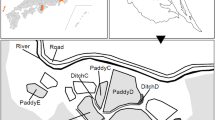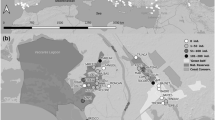Abstract
Background
Notonecta montandoni is currently considered ‘near threatened’ according to the Red List of Japan.
Aims/methods
This study aimed to elucidate the life history of N. montandoni using rearing and field surveys and to describe the life history and developmental period of each immature stage.
Results
The complete developmental period at 19 °C was observed for 97–105 days (n = 5) as follows: egg, 18–22 days (n = 30); first instar nymph, 9–12 days (n = 30); second instar nymph, 9–11 days (n = 30); third instar nymph, 11–15 days (n = 24); fourth instar nymph, 15–20 days (n = 20); and fifth instar nymph, 31–33 days (n = 5). In the field, adults were collected from both ponds and streams, but nymphs were found only in ponds. Notonecta montandoni is present in waters that do not exceed 24 °C throughout the year and moves through multiple habitats.
Discussion
The results suggest that N. montandoni mates and lays eggs in winter and completes its nymphal period from January to May; it is assumed that N. montandoni is univoltine, new adults that emerge may have a life span of only one season, and N. montandoni uses two habitats (ponds and streams) to complete its life cycle.
Implications for insect conservation
Our results describe the life history and immature stages of N. montandoni and provide important information for in situ and ex situ conservation. These findings provide important implications (e.g., the need for multiple habitats to complete life histories and the importance of mitigating the impacts of temperature increases due to climate change) for developing conservation strategies and activities for N. montandoni.





Similar content being viewed by others
References
Clark LB (1928) Seasonal distribution and life history of Notonecta undulata in the Winnipeg Region, Canada. Ecology 9:383–403. https://doi.org/10.2307/1929407
Hayashi M, Nakajima J, Ishida K, Kitano T, Yoshitomi H (2020) Species diversity of aquatic Hemiptera and Coleoptera in Japan. Jpn J Syst Entomol 26:191–200
Ichiyanagi H (2000) Life history of the stream-dwelling bug Aphelocheirus vittatus (Heteroptera: Aphelocheiridae) in central Japan. Entomol Sci 3:603–610
Ikawa T, Nakazawa A (2015) Life history of an endangered marine insect Halovelia septentrionalis Esaki (Hemiptera: Veliidae). Psyche J Entomol 2015:1–6. https://doi.org/10.1155/2015/712093
Ikawa T, Nozoe Y, Yamashita N, Nishimura N, Ohnoki S, Yusa K, Hoshizaki S, Komaba M, Kawakubo A (2012) Life histories of two endangered sea skaters Halobates matsumurai Esaki and Asclepios shiranui (Esaki) (Hemiptera: Gerridae: Halobatinae). Psyche J Entomol 2012:1–7. https://doi.org/10.1155/2012/261071
Karube H (2021) Challenge to conservation of the rare aquatic insects of the Satochi (rural settlements) of Amami, Ryukyu, and their current situation. Nat inSects 56(10):10–13 ((In Japanese.))
Leong CY (1962) The life-history of Anisops breddini Kirkaldy (Hemiptera, Notonectidae). Ann Mag Nat Hist 5:377–383. https://doi.org/10.1080/00222936208651259
Ministry of the Environment of Japan (2015) Red data book 2014—threatened wildlife of Japan, vol 5. Gyosei Corporation, Tokyo, Insecta ((in Japanese))
Mitamura T, Hirasawa K, Yoshii S (2017) The handbook of Japanese aquatic insect, Hemiptera. Bun-ichi Sogo shuppan, Tokyo
Mukai Y, Baba N, Ishii M (2005) The water system of traditional rice paddies as an important habitatof the giant water bug, Lethocerus deyrollei (Heteroptera: Belostomatidae). J Insect Conserv 9:121–129. https://doi.org/10.1007/s10841-005-3488-z
Nakajima J, Hayashi M, Ishida K, Kitano T, Yoshitomi H (2020) Aquatic coleoptera and hemiptera of Japan. Bun-ichi Sogo shuppan, Tokyo
Nature Conservation Division Department of Environmental Affairs Okinawa Prefectural Government (2005) Threatened wildlife in Okinawa, 2nd edition (Animals) - Red Data Okinawa -. Nature Conservation Division Department of Environmental Affairs Okinawa Prefectur-al Government, Naha. (in Japanese)
Nature Conservation Division Department of Environmental Affairs Okinawa Prefectural Government (2017) Threatened wildlife in Okinawa, 3rd edition (Animals) - Red Data Okinawa -. Nature Conservation Division Department of Environmental Affairs Okinawa Prefectur-al Government, Naha. (in Japanese)
Ohba SY, Goodwyn PJP (2010) Life cycle of the water scorpion, Laccotrephes japonensis, in Japanese rice fields and a pond. J Insect Sci 10:45. https://doi.org/10.1673/031.010.4501
R Core Team (2020) R: a language and environment for statistical computing. R Foundation for Statistical Computing, Vienna
Saijo H (2001) Seasonal prevalence and migration of aquatic insects in paddies and an irrigation pond in Shimane Prefecture. Jpn J Ecol 51:1–11. https://doi.org/10.18960/seitai.51.1_1. ((in Japanese with English summary))
Sánchez-Bayo F, Wyckhuys KAG (2019) Worldwide decline of the entomofauna: a review of its drivers. Biol Conserv 232:8–27. https://doi.org/10.1016/j.biocon.2019.01.020
Schuh RT, Weirauch C (2020) True bugs of the world (Hemiptera: Heteroptera) classification and natural history, 2nd edn. Siri Scientific Press, Manchester
Tsuzuki Y, Taniwaki A, Inoda T (2000) The perfect manuals for breeding of aquatic insects, rev. edn. Data House, Tokyo ((in Japanese))
Watanabe K (2021) Biology of the small diving beetle Laccophilus yoshitomii Watanabe and Kamite, 2018 (Coleoptera: Dytiscidae) and rearing methods. Coleopt Bull 75:88–92. https://doi.org/10.1649/0010-065X-75.1.88
Watanabe K, Ohba S (2021) Physiological lifespan of Copelatus parallelus Zimmermann, 1920 (Coleoptera: Dytiscidae) under laboratory conditions. Coleopt Bull 75:516–518. https://doi.org/10.1649/0010-065X-75.3.516
Watanabe K, Sumikawa T (2022) Nymphal period and efficient rearing methods of Ranatra unicolor Scott, 1874 (Hemiptera: Nepidae: Ranatrinae). Jpn J Entomol N S 25:3–8. https://doi.org/10.20848/kontyu.25.1_3. (in Japanese with English summary)
Watanabe K, Koji S, Hidaka K, Nakamura K (2013) Abundance, diversity, and seasonal population dynamics of aquatic Coleoptera and Heteroptera in rice fields: effects of direct seeding management. Environ Entomol 42:841–850. https://doi.org/10.1603/EN13109
Watanabe K, Suda M, Fukutomi H (2017) Efficient breeding method of diving beetles for ex situ conservation: Focusing on Acilius kishii Nakane, 1963. Sayabane N S 27:6–12 (in Japanese)
Watanabe K, Inoda T, Suda M, Yoshida W (2021) Larval rearing methods for two endangered species of diving beetle, Cybister chinensis Motschulsky, 1854 and Cybister lewisianus Sharp, 1873 (Coleoptera: Dytiscidae), using laboratory-bred food prey. Coleopt Bull 75:440–444. https://doi.org/10.1649/0010-065X-75.2.440
Acknowledgements
We express our sincere gratitude to Mr. Tomoki Sumikawa (Ishikawa Insect Museum) for his cooperation with the rearing experiments and for confirming the age of the nymphs. Finally, we would like to thank Editage (www.editage.jp) for English language editing.
Funding
The authors did not receive support from any organization for the work submitted.
Author information
Authors and Affiliations
Contributions
All authors contributed to the study conception and design. KW was involved in rearing, data collection for laboratory experiments, and data analysis. MK was involved in material preparation and data collection during the field survey. The first draft of the manuscript was written by KW and all authors commented on the previous versions of the manuscript. All authors have read and approved the final version of the manuscript.
Corresponding author
Ethics declarations
Competing interests
The authors declare no competing interests.
Additional information
Publisher's Note
Springer Nature remains neutral with regard to jurisdictional claims in published maps and institutional affiliations.
Supplementary Information
Below is the link to the electronic supplementary material.
Rights and permissions
Springer Nature or its licensor (e.g. a society or other partner) holds exclusive rights to this article under a publishing agreement with the author(s) or other rightsholder(s); author self-archiving of the accepted manuscript version of this article is solely governed by the terms of such publishing agreement and applicable law.
About this article
Cite this article
Watanabe, K., Kato, M. Life history of Notonecta montandoni (Hemiptera: Notonectidae: Notonectinae) and conservation implications. J Insect Conserv 27, 261–270 (2023). https://doi.org/10.1007/s10841-022-00450-y
Received:
Accepted:
Published:
Issue Date:
DOI: https://doi.org/10.1007/s10841-022-00450-y




